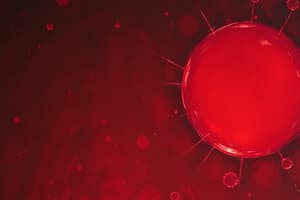Podcast
Questions and Answers
What is the main lipid component of the RBC membrane?
What is the main lipid component of the RBC membrane?
- Cholesterol
- Phospholipids (correct)
- Triglycerides
- Steroids
What type of structure supports the RBC membrane?
What type of structure supports the RBC membrane?
- Protein meshlike cytoskeleton structure (correct)
- Solid lipid layer
- Hollow lipid layer
- Globular lipid structure
Which component forms the framework in which globular proteins move in the RBC membrane?
Which component forms the framework in which globular proteins move in the RBC membrane?
- Phospholipids (correct)
- Triglycerides
- Steroids
- Cholesterol
What did Karl Landsteiner discover related to blood that has relevance to RBC membrane structure?
What did Karl Landsteiner discover related to blood that has relevance to RBC membrane structure?
What is the main function of the Methemoglobin Reductase Pathway?
What is the main function of the Methemoglobin Reductase Pathway?
Which additive solution is used to regenerate ATP and 2,3-DPG levels before RBC freezing?
Which additive solution is used to regenerate ATP and 2,3-DPG levels before RBC freezing?
What is the significant effect of 2,3-diphosphoglycerate on hemoglobin?
What is the significant effect of 2,3-diphosphoglycerate on hemoglobin?
What is the approved preservative solution for storage of RBCs at +1° to +16°C for 35 days?
What is the approved preservative solution for storage of RBCs at +1° to +16°C for 35 days?
What is the main property of integral membrane proteins in the context of the RBC membrane?
What is the main property of integral membrane proteins in the context of the RBC membrane?
What is the effect of decreased phosphorylation of spectrin due to loss of ATP levels?
What is the effect of decreased phosphorylation of spectrin due to loss of ATP levels?
What is the role of RBC cation transport in relation to membrane permeability?
What is the role of RBC cation transport in relation to membrane permeability?
In the context of RBC metabolism, which pathway generates 90% of the ATP needed by the RBC?
In the context of RBC metabolism, which pathway generates 90% of the ATP needed by the RBC?
Flashcards are hidden until you start studying
Study Notes
Lipid Composition and Membrane Structure
- Main lipid component: Phospholipids primarily form the RBC membrane, contributing to its fluidity and structural integrity.
- Support structure: The RBC membrane is supported by a cytoskeletal structure, mainly composed of spectrin, which provides resilience and flexibility.
- Framework for proteins: The cytoskeleton acts as the framework allowing globular proteins to move within the membrane, crucial for various membrane functions.
Discoveries and Functions
- Karl Landsteiner's discovery: Landsteiner identified the ABO blood group system, emphasizing the importance of antigens on the RBC membrane in transfusion medicine and immune response.
- Methemoglobin Reductase Pathway: This pathway maintains normal hemoglobin function by reducing methemoglobin, ensuring effective oxygen transport.
Preservation and Additives
- Additive solution for freezing: A specific solution is used to regenerate ATP and 2,3-DPG levels prior to freezing RBCs, essential for maintaining cellular metabolism and functionality post-thawing.
- 2,3-DPG effects: 2,3-diphosphoglycerate decreases hemoglobin's affinity for oxygen, enhancing oxygen delivery to tissues.
Storage and Membrane Properties
- Approved preservative solution: An approved solution for storing RBCs at +1° to +16°C, effective for up to 35 days, ensures viability and functionality during storage.
- Integral membrane proteins: These proteins are characterized by their ability to span the lipid bilayer, playing key roles in transport and signaling.
Cellular Functionality
- Decreased phosphorylation of spectrin: Loss of ATP results in decreased spectrin phosphorylation, leading to impaired membrane stability and increased fragility of RBCs.
- RBC cation transport: Critical for maintaining membrane permeability, cation transport regulates ion concentrations, which is vital for cell function and volume.
- ATP generation pathway: The Embden-Meyerhof pathway is the primary metabolic pathway generating approximately 90% of the ATP required by RBCs, essential for cellular processes.
Studying That Suits You
Use AI to generate personalized quizzes and flashcards to suit your learning preferences.




